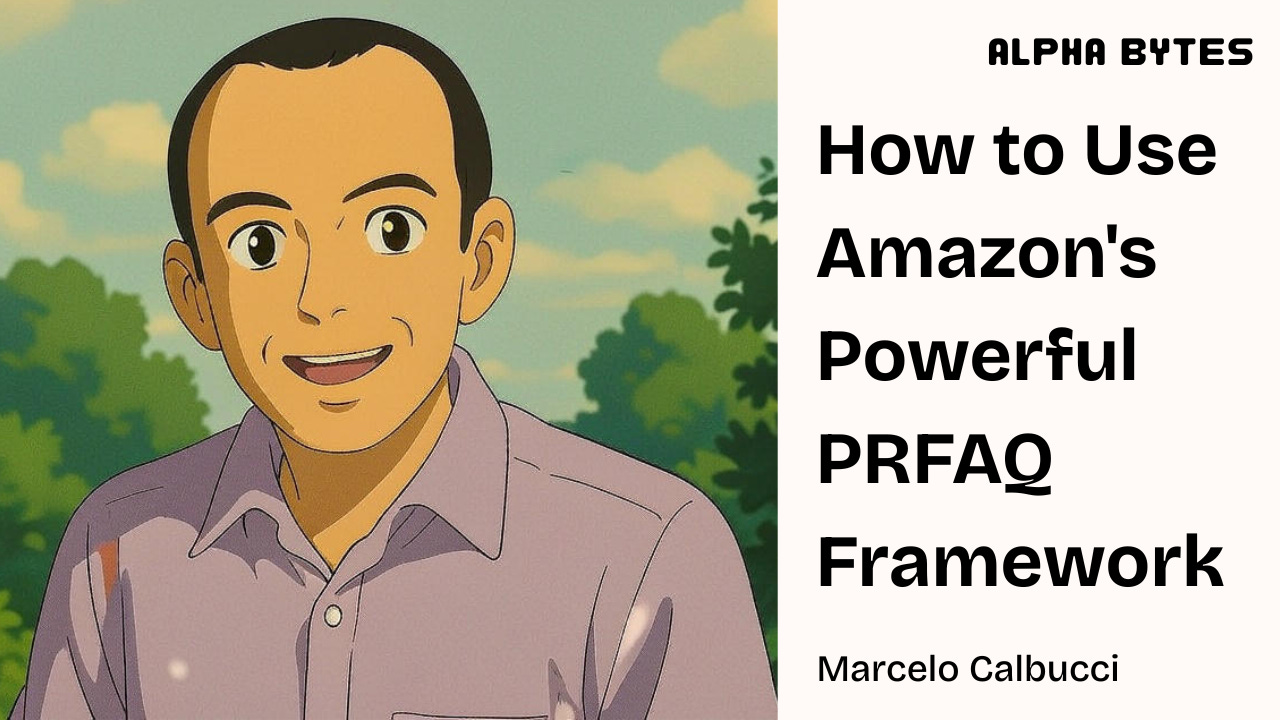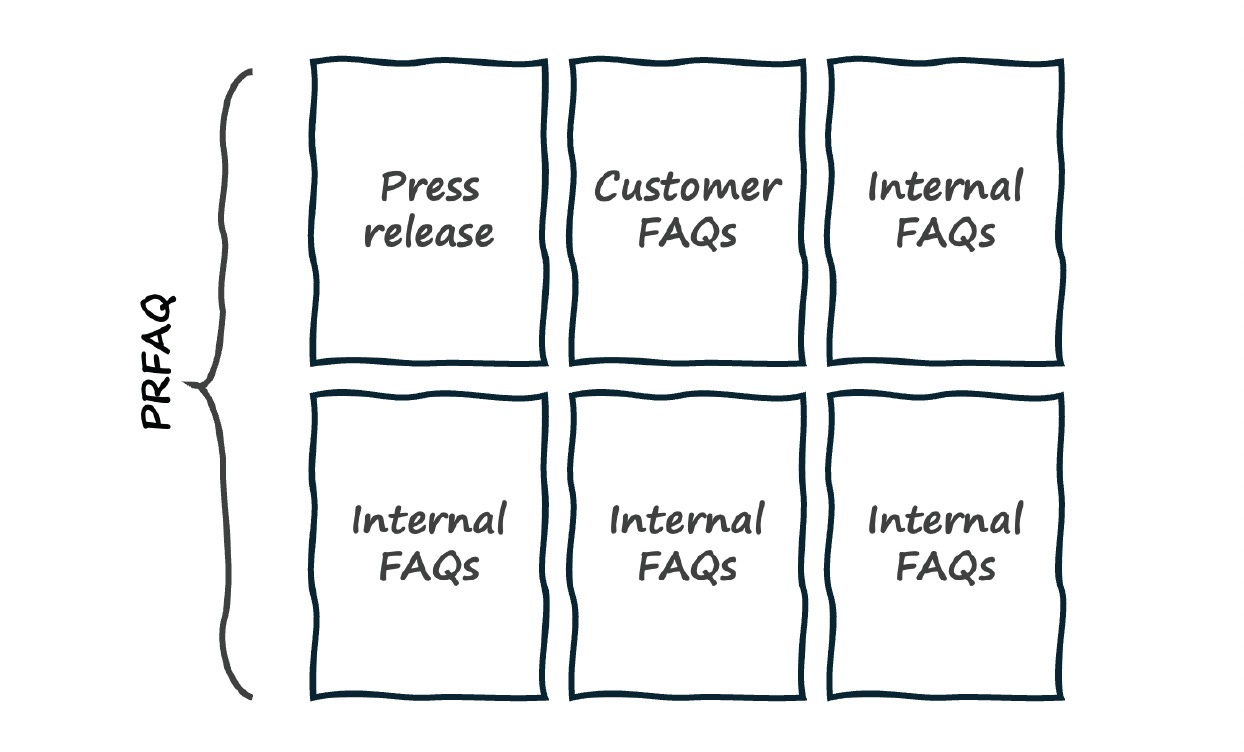How to Use Amazon's Powerful PRFAQ Framework For Anything! | Marcelo Calbucci (ex-Amazon, Microsoft)
Welcome to the ‘NewFounder’ edition of the newsletter. This is where we go down the rabbit hole on tactical advice to help you become a better builder, leader and thinker. We also release a weekly newsletter (The Weekly Signal) showcasing the latest curated signals that caught our attention. Thanks for reading.
Dear Readers:
This is the first of what I hope to be many in a series of posts to help founders and operators become better builders. While there are many outlets for founder and entrepreneurial advice, there aren’t many geared towards providing real-world tactical experience, especially at the very early stages. This is why we created the ‘The New Founder’ section of the newsletter. Its main goal is to provide high-quality insights into what it takes to get your first customer, build your product, integrate AI into your workflows, raise money (if that’s what you want), hire the right people, and so many other areas.
To that end, today, I’m beyond excited to share this tactical post with all of you on PRFAQ by Marcelo Calbucci—with origins at Amazon, it’s becoming much more mainstream and for good reason. It’s a powerful tool that’s changing the way organizations build products.
The PRFAQ framework isn’t just about writing a document—it’s a type of mindset that aligns teams, reduces risks, and empowers everyone, from junior engineers to seasoned leaders, to think strategically. It doesn’t matter if you’re launching a startup, driving change in a large org, or even tackling a personal project; this article will equip you with actionable steps to clarify your vision, engage stakeholders, and make smarter decisions.
Marcelo Calbucci, a seasoned operator and founder with roots at Microsoft (Development Manager), Amazon (Director of Product & Tech), and multiple startups (Hiya, etc.), generously unpacks the method that’s driven success at one of the world’s most influential companies.
To get the full breakdown on PRFAQ and how to apply it to just about anything, you can grab Marcelo’s book: The PRFAQ Framework. You can also follow him on LinkedIn, Bluesky, or X.
For a limited time, Marcelo is offering readers 20% off the PDF version of his book here — you can use the code ALPHABYTES20.
Happy reading!
Barry.
With a career spanning Microsoft, 18 years in startups, and a stint at Amazon, I’ve experienced the highs and lows of building products and strategies across diverse organizations
I want to share with you the PRFAQ framework—a powerful tool I discovered at Amazon that’s not only shaped my professional life but also inspired me to write a book about it. At Amazon, I encountered a unique culture defined by two pillars: its leadership principles (like customer obsession and disagree and commit) and a pervasive writing and reading ethos. Unlike traditional organizations, there are no PowerPoint slides here. Instead, it’s just strong narratives and frameworks that drive everything from strategy to incident reports. It was strange at first, sitting in meetings where everyone read silently for 20 minutes before discussing anything, but it quickly became clear why this approach was so powerful. It was during this time that I fell in love with PRFAQ, a framework that crystallized my experiences into a method I now champion for organizations big or small.
My goal with this book and sharing this post is to hopefully democratize the PRFAQ framework for non-Amazonians. I want to demonstrate that you can adapt a framework that was once only meant for a specific organization and streamline it for different companies and products.
Whether you’re a founder, a product manager, an engineer, or part of a larger team, I hope this will show you how PRFAQ can unlock clarity, alignment, and success in your projects.
What Is PRFAQ?
Amazon adopted the PRFAQ format in the mid-2000s as part of a set of frameworks for decision-making, building, and operating its business. These are part of the famous Working Backwards method, popularized by Colin Bryar and Bill Carr. PRFAQ is the crown jewel of the Amazon Working Backwards process.
The PRFAQ stands for Press Release & Frequently Asked Questions. It’s a framework and method designed to discover, debate, and decide on the vision and strategy for a product, program, or business initiative—before you invest significant time or resources. Unlike traditional approaches that lean on slide decks or OKRs (Objectives and Key Results), PRFAQ uses writing to force clarity, align teams, and reduce risks.
At its core, PRFAQ is about working backwards from the desired outcome. Imagine launching a product that solves a real problem for customers while delivering value to your business. Now, write that story as if it’s already happened, then figure out how to make it real.
A PRFAQ works well to identify early issues with an idea before significant investments are made. It gives you and the people reviewing it the flexibility to “experiment” without building prototypes or full products, or programs. Because a PRFAQ is a structured narrative, it’s easy to change and iterate. It’s also “unfinished” enough that the full solution is left to people’s imagination. It allows people to speak more candidly about their views without feeling they are criticizing the color scheme or the registration flow.
The PRFAQ Principles
The five principles of the PRFAQ are:
Customer-centric: It starts from the customer, and it captures their needs, pain points, or desires. It captures how customers are being (under)served today, who they are, and what matters to them.
Aspirational: It’s an aspirational vision that is feasible, viable, usable, and valuable.
Clear, concise, and coherent: It presents the project in its best possible light. It’s easy for the people involved in the project to understand, and it’s logical.
Truth-seeking: It is a mechanism to learn and discover. It’s not a way to manipulate opinions or force ideas onto people. It evolves at each round of review, improving its accuracy.
A strategic decision-making tool: It’s a tool to decide if the team should pursue a project, why, and when.
The Anatomy of a PRFAQ Document
A PRFAQ document has three distinct parts, each serving a unique purpose but working together to create a cohesive strategy.
Before diving in, I highly recommend you read a sample PRFAQ here — it will help you in better understanding each component of the document with clarity.
1. The Press Release (PR)
The first page is a press release written in the present tense, as if your product or initiative has just launched. It’s not for public consumption—it’s an internal tool to paint a vivid picture of the future. It describes the problem you’re solving, the solution you’re offering, and the impact it’s having. I often include a fictional customer quote to bring the vision to life. This isn’t about hype; it’s about setting the stage for what’s to come.
In a PRFAQ, you are not writing a press release to see it published. It’s for internal use only. The PR in a PRFAQ has a future date when you realistically expect to announce your product. You write a press release as if you were there on that day. You are painting a vision of this project. This is a powerful mechanism to make sure your (extended) team feels comfortable with the vision and is excited about it. It’s essential for the people involved in the project, including backers (investors or executives), people working on the project, and even your customers and stakeholders, to align on the promise.
Here’s the core structure:
Location
Date
Headline
Sub-headline
Lead paragraph (Intro)
Problem paragraph
Solution paragraph
Internal quote paragraph
How it works paragraph
Customer quote paragraph
How to get started paragraph
2. Customer FAQs
Next comes a page of customer-focused frequently asked questions, also in the present tense. These anticipate what customers might ask if the product existed today: “How much does it cost?” “How do I integrate it with my tools?” “Can my team use it too?” This forces you to think from the customer’s perspective, ensuring your solution is practical and user-centric.
This section is double-fictional (on top of being hypothetical). It’s fictional because your customers won’t read this. None of it exists, and you are just illustrating a few key points of the solution. The second fictional part is that you are writing this to make strategic decisions, not necessarily to answer a customer’s most pressing questions. If a customer “question” in this section doesn’t serve the needs of the reviewers, it’s not adding value to the document.
The tricky part of selecting your customer FAQs is that you want to include only clarifying questions or topics of discussion for your reviewers. For example, customers are interested in an FAQ on integrating their fitness tracker to sync its data with the service. However, from a strategic conversation perspective—as long as it has been proven this is possible—that’s not a valuable question because there is no contentious point or impact on the discussion. A more valuable question would be which fitness trackers are available at launch time.
Here’s a list of themes for the customer FAQ:
Value
Usability
Plans and Pricing
Privacy
Migration (or change management)
Risk
Compatibility & Integrations
3. Internal FAQs
The final four pages are internal FAQs, where the heavy lifting happens. Here, this is where you dive into the value, feasibility, usability, and viability of the project.
The internal FAQs section is the bulk of your document and will have the most direct and valuable insights on this project. It’s wrong to assume that because it’s an “FAQ,” it’s supplemental information. The press release and the customer FAQs are just to set the stage. The internal FAQs are the main show.
The customer FAQs and the internal FAQs are both internal! The difference is that we write the customer FAQs as if the customer is asking, and the internal FAQs as if someone on the team is asking. Another difference is that the customer FAQs represent a desirable future state, but we write them in the present tense. It’s aspirational. The internal FAQs are in the present, helping us make decisions about this project. The internal FAQs must be based on concrete information. If it’s based on assumptions or hypotheses, it needs to be called out as such.
This section has between two and four pages. The sweet spot will be between twelve and eighteen FAQs. If you find yourself with too few questions, you have not empathized enough with your collaborators to understand what they’ll care about. If you find yourself with too many questions, you might have gone too tactical, detailed, or verbose.
Again, I highly suggest you read the example here.
Crafting a PRFAQ as a Project
Keep reading with a 7-day free trial
Subscribe to Alpha Bytes to keep reading this post and get 7 days of free access to the full post archives.








